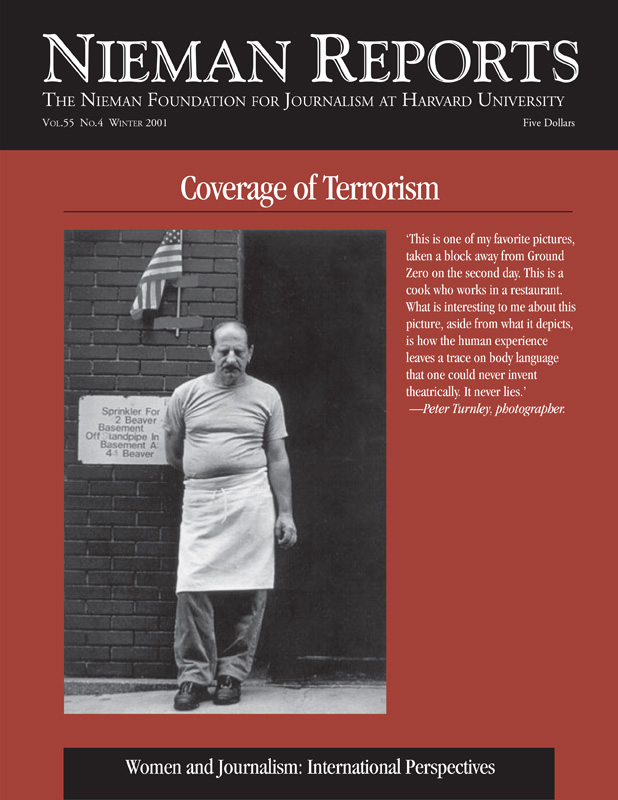Through the night of September 11, 2001, photographer Peter Turnley took refuge in a second-floor office in a clothing store, its windows blown out by the force of the attack on the World Trade Center. As he tried to absorb what he was seeing, he documented the devastation. At dawn, he moved close to the site and fastened his journalistic eye on faces whose expressions evoke our feelings of loss. From covering war, Turnley knew that “the most important pictures…are after the battle, when one sees the human impact.”
This photographic glimpse at the human impact of that tragic morning opens Nieman Reports’s exploration of the challenges journalists confront as they tell the stories of that day and report on its still-unwinding reverberations.
“Language always matters,” writes Trinity College professor Beverly Wall, as she examines difficulties journalists have in finding words adequate to describe what happened on that September morning. “When journalists’ impulse is to describe a news event as ‘indescribable,’ perhaps they should pause and remind themselves that language does matter and the exacting search for words should not be abandoned.”
Ted Gup, author of “The Book of Honor: Secret Lives and Deaths of CIA Operatives,” takes us inside the tension between government and the press when secrecy is employed as part of a wartime strategy. “It is precisely in times of such crises that reporters should be wariest of government invocations of secrecy,” he writes. Stanley W. Cloud, former Washington bureau chief for Time and one of five journalists who, after the Gulf War, negotiated an improved way of handling pool coverage of U.S. military combat, writes about the interaction of the Pentagon and the press. Maud S. Beelman, who directs the International Consortium of Investigative Journalists and covered the wars in the Balkans for The Associated Press, contends that “For reporters covering this war, the challenge is not just in getting unfettered and uncensored access to U.S. troops and the battlefield—a long and mostly losing struggle in the past—but in discerning between information and disinformation.” Nancy Bernhard, author of “U.S. Television News and Cold War Propaganda, 1947-60,” reminds us of a time during the cold war when Harry Truman asked journalists for “ideological support for the national security state” and, as she writes, “none of the assembled newsmen blanched at this enlistment to propagandize.” As James Bamford, author of “Body of Secrets: Anatomy of the Ultra-Secret National Security Agency,” examines the Bush administration’s crackdown on civil liberties and the limitations on press freedoms—some of them self-imposed—he finds “potential for good, penetrating, investigative reporting.” But, he writes, “The question is, is the media up to these investigative tasks? Judging from past performance, the answer is not likely.”
Bamford uses media coverage of anthrax as one example of how the press is failing the American public. Philip Caper, a physician who lectures at the Harvard School of Public Health, explains how reporting on anthrax and related public health issues could be handled more responsibly by journalists. And Stanford journalism professor and former St. Louis Post-Dispatch editor William Woo explains what foreign news would be like if it were covered in “a serious way.”
John Owen, who directed The Freedom Forum European Center until its closure this fall, tells the story of a British journalist, untrained in the coverage of war, who nearly loses her life in Afghanistan as a reminder of why training—that is now available—is so critical for reporters whose job takes them into hostile environments. Nate Thayer, an investigative journalist, uses his experiences from years of reporting in Cambodia on Khmer Rouge leader Pol Pot to explain why today so many staff journalists rely on the legwork of freelancers to bring context to their foreign news coverage. American University professor Christopher Simpson offers us his expertise about satellite images, explaining what information these photographs can give journalists and why the U.S. government is blocking reporters’ access to them. Joanne Miller, art director at The Charlotte Observer, describes how her newspaper uses graphics to help readers better understand the coverage of the terrorism story.
During the Nieman Foundation’s Watchdog Conference in September, Harvard Law School professor Charles Nesson moderated a discussion about how journalists ask probing questions, focusing on coverage of terrorism and whether journalists are asking “the right question.”
Boston Globe photographer Stan Grossfeld went to New York City after September 11 and returned with images that probe the human spirit in the midst of destruction.
Geneive Abdo, a longtime Tehran correspondent for The Guardian, illuminates the difficulties Western journalists confront in reporting about the Islamic world. She observes that many American reporters “reveal an intellectual laziness and a general unwillingness to cover the Muslim world in a way that allows readers to view it on its own terms without moral judgment, which is, after all, the way in which understanding is deepened.” Williams College professor David B. Edwards, who is working to preserve a vast archive of reporting about Afghanistan during the 1980’s, shares photographs taken during an earlier war as part of a controversial journalism project. Reza, a photographer who has traveled often to Afganistan, offers his look at the country’s fighters and her people. Fazal Qureshi, chief editor of Pakistan Press International, writes about the forces of intimidation that play upon his country’s independent press. Suffolk University professor Abdelmagid Mazen, an Egyptian by birth, explains what it is like to experience dual coverage of the war on terrorism as he switches between Al-Jazeera’s satellite feed and American news coverage. Danny Schechter, executive editor of Globalvision’s mediachannel.org, describes how his Web-based global news service helps readers dig deeper and broader for answers to questions such as why the events of September 11 happened. And Dale Fuchs, an American who works for the national Spanish daily, El Mundo, shows us how her native country is portrayed to people living in Spain—“as a high-tech bully wreaking havoc on the poor with its array of terrible toys”—then explains why.


